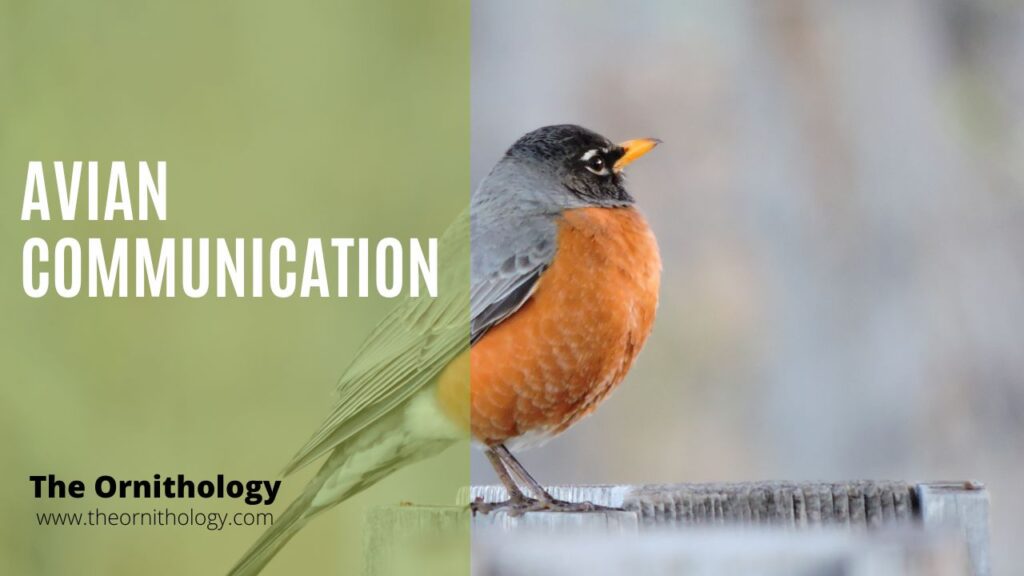Vocalizations: Calls and Songs

Avian communication involves a rich array of vocalizations that play essential roles in mate attraction, territory establishment, and maintaining social bonds:
- Calls: Calls are short, often simple vocalizations used for various purposes such as alerting others to danger, coordinating group movement, or locating mates. Alarm calls warn of predators, while contact calls keep flock members together.
- Songs: Songs are more complex vocalizations primarily used by males during the breeding season. Songs serve multiple functions, including mate attraction, territory defense, and signaling genetic fitness. Each species has a unique song, enabling individuals to recognize their own kind.
Visual Displays and Body Language
Avian communication extends beyond vocalizations to encompass visual displays and body language:
- Visual Displays: Visual displays involve movements, postures, and gestures that convey messages. Courtship displays, like strutting or dancing, signal readiness to mate, while dominance displays establish social hierarchies.
- Body Language: Birds communicate through body language, using movements like head bobbing, wing-flapping, and tail flicking to convey emotions, intentions, and dominance.
Role of Communication in Social Hierarchies
Communication is crucial for establishing and maintaining social hierarchies within bird communities:
- Dominance Displays: Many bird species engage in dominance displays to establish pecking orders within a group. Dominant individuals use aggressive postures and displays to assert their authority.
- Territoriality: Vocalizations and displays are used to define and defend territories. Birds sing to declare ownership and ward off potential intruders.
- Parent-Offspring Communication: Parent birds use vocalizations and visual cues to communicate with their chicks, conveying information about food availability, danger, and guidance for flight.
- Cooperative Breeding: In species with cooperative breeding, individuals collaborate in rearing offspring. Communication helps coordinate tasks, allocate responsibilities, and ensure the survival of young birds.
Avian communication is a complex web of vocalizations, displays, and behaviors that facilitate interaction within bird communities. The ability to convey information through calls, songs, and visual cues is vital for reproductive success, group cohesion, and the maintenance of social order.
Frequently Asked Questions (FAQ) – Avian Communication
Why do birds communicate through vocalizations?
Birds use vocalizations for various purposes, including alerting others to danger, finding mates, establishing territories, maintaining social bonds, and coordinating group movements.
What’s the difference between calls and songs in birds?
Calls are short and simple vocalizations used for specific purposes like alerting, while songs are more complex and often serve functions like mate attraction, territory defense, and communication within a species.
Do all birds sing or make calls?
Yes, almost all bird species have some form of vocal communication. Even birds that may not have elaborate songs often use calls to convey information to others.
How do birds convey emotions through visual displays?
Birds use body language and visual displays like wing-flapping, head movements, and postures to convey emotions such as aggression, submission, and readiness to mate.
How do birds establish territories through communication?
Birds use vocalizations and displays to define and defend their territories. Singing and visual displays signal ownership and discourage other individuals from entering their designated areas.
Can bird communication differ between species within the same area?
Yes, different bird species often have distinct calls and songs, even if they inhabit the same area. This differentiation helps prevent confusion and allows individuals to recognize their own kind.
Do birds communicate with their offspring?
Yes, parent birds communicate with their offspring through vocalizations and visual cues. They convey information about food availability, danger, and guidance, helping the young birds survive and learn essential skills.
How does communication play a role in cooperative breeding?
In species with cooperative breeding, communication is crucial for coordinating tasks among group members involved in rearing offspring. Communication helps allocate responsibilities and ensure the young birds’ well-being.
Can humans understand bird vocalizations and body language?
While humans can learn to interpret some bird vocalizations and behaviors, the intricacies of avian communication can be complex and species-specific. Birdwatchers, researchers, and enthusiasts often study these behaviors to gain insights into bird behavior and ecology.
